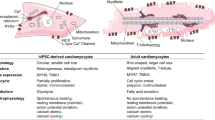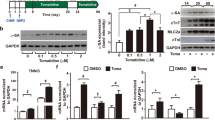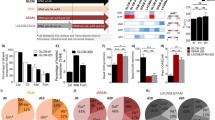Abstract
Various chemicals have been reported to induce the differentiation of human embryonic stem cells (hESCs) into cardiomyocytes (CMs), however, their contributions to the functionality of hESC-derived CMs are still limited. In this study, we evaluated the effects of red ginseng extract (RGE), ginsenoside-Rb1 (gRb1, panaxadiol), and ginsenoside-Re (gRe, panaxatriol) on the differentiation of hESCs and the functionality of derived CMs. Undifferentiated hESCs were treated with 0.25 mg/mL RGE, 10 μmol/L gRb1, or 10 μmol/L gRe for 48 hours at the differentiation induction (early stage) or maturation (late stage) period. The expression of mesodermal and cardiac transcription factor genes was upregulated in the ginsenoside-treated groups from early stage. The expression of cardiac sarcomeric genes was significantly upregulated at the late stage. The gRb1- and gRe-treated groups upregulated the expression of potassium voltage-gated channel subfamily E member 1 (KCNE1) and the gRe-treated group showed a longer beating duration compared to the control. Taken together, ginsenosides may enhance the functionality of hESC-derived CMs in vitro.
Similar content being viewed by others
References
Kehat I, Kenyagin-Karsenti D, Snir M, et al. Human embryonic stem cells can differentiate into myocytes with structural and functional properties of cardiomyocytes. J Clin Invest. 2001;108(3):407–414.
Oh SK, Kim HS, Ahn HJ, et al. Derivation and characterization of new human embryonic stem cell lines: SNUhES1, SNUhES2, and SNUhES3. Stem Cells. 2005;23(2):211–219.
Filipczyk AA, Passier R, Rochat A, Mummery CL. Regulation of cardiomyocyte differentiation of embryonic stem cells by extracellular signalling. Cell Mol Life Sci. 2007;64(6):704–718.
Harvey RP. Patterning the vertebrate heart. Nat Rev Genet. 2002;3(7):544–556.
Ladd AN, Yatskievych TA, Antin PB. Regulation of avian cardiac myogenesis by activin/TGFbeta and bone morphogenetic proteins. Dev Biol. 1998;204(2):407–419.
Laflamme MA, Chen KY, Naumova AV, et al. Cardiomyocytes derived from human embryonic stem cells in pro-survival factors enhance function of infarcted rat hearts. Nat Biotechnol. 2007;25(9):1015–1024.
He JQ, Ma Y, Lee Y, Thomson JA, Kamp TJ. Human embryonic stem cells develop into multiple types of cardiac myocytes: action potential characterization. Circ Res. 2003;93(1):32–39.
Passier R, Denning C, Mummery C. Cardiomyocytes from human embryonic stem cells. Handb Exp Pharmacol. 2006;(174):101–122.
Jang J, Ku SY, Kim JE, et al. Notch inhibition promotes human embryonic stem cell-derived cardiac mesoderm differentiation. Stem Cells. 2008;26(11):2782–2790.
Jung CH, Seog HM, Choi IW, Choi HD, Cho HY. Effects of wild ginseng (Panax ginseng C.A. Meyer) leaves on lipid peroxidation levels and antioxidant enzyme activities in streptozotocin diabetic rats. J Ethnopharmacol. 2005;98(3):245–250.
Kim YY, Ku SY, Jang J, et al. Use of long-term cultured embryoid bodies may enhance cardiomyocyte differentiation by BMP2. Yonsei Med J. 2008;49(5):819–827.
Pekkanen-Mattila M, Kerkela E, Tanskanen JM, et al. Substantial variation in the cardiac differentiation of human embryonic stem cell lines derived and propagated under the same conditions–a comparison of multiple cell lines. Ann Med. 2009;41(5):360–370.
Helms S. Cancer prevention and therapeutics: panax ginseng. Altern Med Rev. 2004;9(3):259–274.
Attele AS, Wu JA, Yuan CS. Ginseng pharmacology: multiple constituents and multiple actions. Biochem Pharmacol. 1999;58(11):1685–1693.
Gillis CN. Panax ginseng pharmacology: a nitric oxide link? Biochem Pharmacol. 1997;54(1):1–8.
Toh HT. Improved isolated heart contractility and mitochondrial oxidation after chronic treatment with Panax ginseng in rats. Am J Chin Med. 1994;22(3–4):275–284.
Chu GX, Chen X. Anti-lipid peroxidation and protection of ginsenosides against cerebral ischemia-reperfusion injuries in rats. Zhongguo Yao Li Xue Bao. 1990;11(2):119–123.
Kim YY, Ku SY, Rosenwaks Z, et al. Red ginseng extract facilitates the early differentiation odf human embryonic stem cells into mesendoderm lineage. Evid Based Complement Alternat Med. 2011;2011. pii: 167376.
Oh SK, Kim HS, Park YB, et al. Methods for expansion of human embryonic stem cells. Stem Cells. 2005;23(9):605–609.
Kim YY, Ku SY, Liu HC, et al. Cryopreservation of human embryonic stem cells derived-cardiomyocytes induced by BMP2 in serum-free condition. Reprod Sci. 2011;18(3):252–260.
Kim YY, Ku SY, Huh Y, et al. Anti-aging effects of vitamin C on human pluripotent stem cell-derived cardiomyocytes. Age (Dordr). 2013;35(5):1545–1557.
Furukawa T, Bai CX, Kaihara A, et al. Ginsenoside Re, a main phytosterol of Panax ginseng, activates cardiac potassium channels via a nongenomic pathway of sex hormones. Mol Pharmacol. 2006;70(6):1916–1924.
Wang YG, Zima AV, Ji X, Pabbidi R, Blatter LA, Lipsius SL. Ginsenoside Re suppresses electromechanical alternans in cat and human cardiomyocytes. Am J Physiol Heart Circ Physiol. 2008;295(2):H851–H859.
Scott GI, Colligan PB, Ren BH, Ren J. Ginsenosides Rb1 and Re decrease cardiac contraction in adult rat ventricular myocytes: role of nitric oxide. Br J Pharmacol. 2001;134(6):1159–1165.
Author information
Authors and Affiliations
Corresponding author
Rights and permissions
About this article
Cite this article
Kim, Y.Y., Ku, J.B., Liu, H.C. et al. Ginsenosides May Enhance the Functionality of Human Embryonic Stem Cell–Derived Cardiomyocytes In Vitro. Reprod. Sci. 21, 1312–1318 (2014). https://doi.org/10.1177/1933719114525269
Published:
Issue Date:
DOI: https://doi.org/10.1177/1933719114525269




